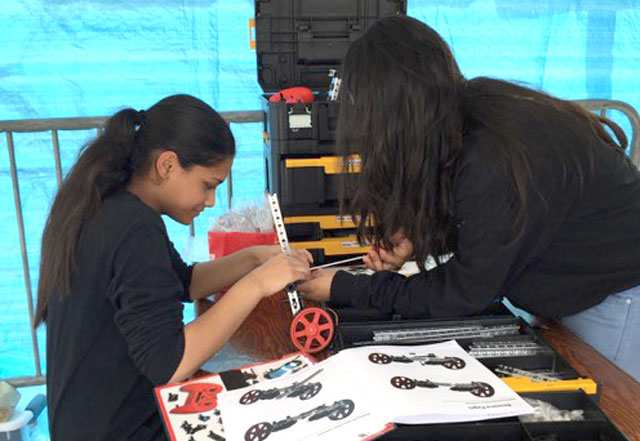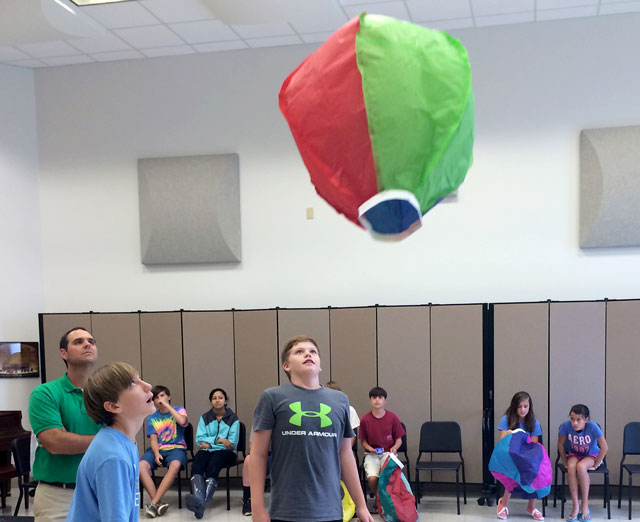Updated 4/16/24
Summer camp has been part of young peoples’ lives for decades, where they create memories, build camaraderie, and learn skills that they carry with them for life. But today, summer camp doesn’t have to be about camping as there are many different camps available – and STEM-focused camps continue to gain popularity!
While STEM camps have amazing learning potential and can broaden students’ horizons, they must be fun and engaging to compete with carefree fun and play in the sunshine.
To get this perfect combination of fun and learning, summer camp organizers have a big job on their hands. So, for those of you who are getting ready to tackle the camp season, we’ve talked to three people who have run a variety of camps, including robotics, curriculum-based, and activity-based STEM camps. Their tips and insights will help you become a summer camp guru, no matter what kind of camp you’re planning!
Plan a Robotics Camp
Robotics are hugely popular, but a robotics camp requires a lot of know-how to build and code a robots in a large group. Matt Snyder, robotics mentor for the St. Louis Student Robotics Association, along with his partner Dr. Robin Lady, have experience running robotics camps and had two different camps planned.
The first was more traditional, like the camps they've done in years past, where kids use TETRIX® PRIME to build a robot and then program the robot’s actions using Arduino. The second camp is radically different: the duo partnered with membership-based workshop that also held classes for adults and young people. Campers use laser etchers and vacuum formers to create custom parts and body shells for their PRIME robots, which must play offensive or defensive positions in a robotic basketball game that combines programming and remote control.

Matt’s Top 3 Tips:
- Expect mixed reactions to the activities. Participants will vary in enthusiasm for and knowledge of robotics, so you shouldn't expect everyone to start with the same skill set or excitement. “Planning for that is an important step. A given session [in our camp] would have a variety of activities, some of which were robotics and some were different. You have to be able to pivot depending on the interest level of the kids.”
- If coding is part of your camp, especially with younger students, make sure to include R/C too. “They instinctively want to grab the remote control. They’re magnetically drawn to remote controls. If there’s not one, the kids are not as interested. So, you engage them with the R/C, then you introduce the autonomous behavior, and the kids make the leap in their minds.”
- Keep computers in mind, especially for programmable robots that require software. If you're using an institution’s computers, work with their staff to install needed software AND libraries before the camp starts.
Product Highlight:
TETRIX PRIME proves a good choice for their workshops and younger students. “TETRIX PRIME is perfect for kids who just want to make robots and are not yet tool savvy. With any other robotics system, there is a barrier of working with tools. It’s a real impediment when you’re teaching robotics because you’re not teaching tools. You’re teaching specific mechanical principles and programming and logic and sensors. That’s why we love TETRIX PRIME, because you can do it without tools for the most part.”
Make Camp Worth Their While
Cara Baldtree teaches science in Salt Lake City, Utah, for Grades 3-6 and was one of our Pitsco Scholarship winners in the past. She implemented her school’s first STEM summer camp in 2016 with several teachers. Her advice is to bring out the most engaging hands-on activities you can to encourage camper interest and participation.
For their camp, they had three days of rotating classes – electricity, light, and sound – and on the fourth day, students learned rocketry basics.
“This was the favored day for many students,” Cara said. “There’s an almost magical component to launching objects and measuring the height or distance. In fact, the excitement carried over to our school science fair where some of those same students built differently shaped rockets and tested which design was the most effective.”
Cara’s Top 3 Tips:
- The foundation of a camp should be “amazing and highly engaging activities as well as teachers who are enthusiastic. If students leave the first day learning through PowerPoints, worksheets, and the teacher talking about rules, then many students won't return and/or will be turned off to STEM. Remember, it's their summer vacation. It needs to be worth their time.”
- Mum's the word. “It's important that teachers remember that they should do minimal talking because students learn best when they are doing the talking and exploring.”
- If you're using a predesigned camp program, research it to ensure it matches your goals.
Product Highlight:
“My favorite Pitsco product so far is the Straw Rocket Launcher. I have students in different grades and classes begging me to pull out the Straw Rocket Launcher. It’s a perfect outside STEM activity that produces highly engaged students!”
Take STEM From Class to Camp
In the past, Academic Dean Dr. Keith Rice oversaw a large-scale implementation of Pitsco STEM curriculum in UMS-Wright schools. To ease the transition to STEM-based Missions and Modules [since then, Pitsco has retired Modules and transitioned to Expeditions] labs, the Mobile, Alabama, school and Pitsco Education education advisors came up with the idea of a summer camp.
The 2-week program offered kids a chance to explore a Mission or Module that was in the classroom they would enter in the fall, while the teachers received hands-on experience facilitating the new hands-on curriculum. The following year, they offered a scaled-back version of the program. The private school is considering making a summer camp open to the public. Keith sees a big plus for any student who can take advantage of summer camps.
“I think it keeps kids engaged,” he said. “They are naturally inquisitive and, frankly, I think a lot of kids get bored during the summer – though they might not admit that – and are looking for things to do.”
“Having an opportunity to just be curious and to have fun and learn to work together in a little less threatening or demanding situation, I think is a good thing,” he added. “[It’s] learning for learning’s sake as opposed to learning to make an A. That’s what happens a lot of the time during the school year.”

Keith’s Top 3 Tips:
- Bring in a competitive edge. “Anytime there’s a bit of a competition element and they’re working together with some of their friends, I think those are some of the things you need to do,” Keith said. He adds that being able to individualize their projects by decorating them helps too.
- Organization is a must for a camp program. “Organization, obviously, is really important. You want to have all your materials ready to go and the students organized before they come into the room so you can use the time in the best way possible.”
- Be flexible in a camp setting – and not just due to varying student interest. Because summer camps are not mandatory, you might have some kids not show up. Being flexible for that is important too.
![]()
We love sharing tips from the experts like these educators, those with tried-and-true experiences. Follow their lead and you're sure to have a great camp this season!
And, if you're still looking for resources, check out our Summer Camps Solution Guide.
And, remember, summer camps are supposed to be fun! Check out these other out of school STEM examples, or send us a note and let us help!

